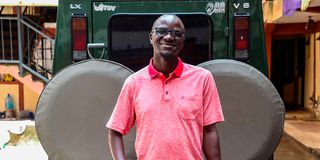Why Kenyan youth are increasingly suffering stroke

Steve Opondo, 32, during the interview at his home in Rongai on May 14, 2025. He suffered a hemiplegic stroke at the age of 16.
What you need to know:
- Lifestyle factors include unhealthy diets such as high intake of processed foods, salt, sugar, and unhealthy fats, which contribute to hypertension and obesity, physical inactivity, smoking, excessive alcohol use as well as drug and substance abuse.
Imagine waking up one day—healthy, energetic—only to collapse the next, your limbs paralysed forever.
Suddenly, you lose basic, everyday functions such as holding a comb, brushing your teeth, or signing your name. Then comes the medical verdict: no cure, no reversal. This is your new normal.
For many young Kenyans, this nightmare is a reality. Strokes, once considered an "old person’s disease," are now striking youths as young as 16.
Valerie Nafula, 26
As she opens the gate to her parents’ home in Kandisi, Ongata Rongai, she is wearing a brave smile. We later learn that beyond that beautiful radiant smile is a warrior who was not only born with sickle cell disease, but is now battling an ischemic stroke.

Valerie Nafula, 26, during the interview at her parents’ home in Kandisi, Rongai on May 14. She got a stroke attack while in Form Two.
“One morning while in Form Two in 2014, I was just going about my day when suddenly a painless chill that would change my life forever raced down my spine. I collapsed and was rushed to hospital, where doctors established that the stroke was caused by sickle cell. It affected my right arm and leg,” she tells Healthy Nation.
The left part of her brain was also immensely affected. "I can’t cook, wash, or do things I used to," she says.
But what causes a stroke?
According to the US National Heart, Blood and Lung Institute, a stroke can occur when blood flow to the brain is blocked or there is sudden bleeding in the brain.
There are two types of strokes.
A stroke that occurs because blood flow to the brain is blocked is called an ischemic stroke.
“The brain cannot get oxygen and nutrients from the blood. Without oxygen and nutrients, brain cells begin to die within minutes,” the Institute highlights. A stroke that occurs because of sudden bleeding in the brain is called a haemorrhagic stroke.
“The leaked blood results in pressure on brain cells and damages them. Just under 90 per cent of strokes involve blocked blood vessels (ischemic), and the rest involve internal bleeding (haemorrhagic),” the Institute adds, noting that strokes are further classified based on where in the brain the blockage or bleeding occurs.
The World Health Organization (WHO) cautions that a stroke carries a high risk of death. Survivors can experience loss of vision and/or speech, paralysis and confusion.
Having a stroke significantly increases the risk of future strokes, which are known as recurrent strokes, while the risk of death depends on the type of stroke.
“Transient ischaemic attacks, where symptoms resolve in less than 24 hours, have the best outcome, followed by stroke caused by carotid stenosis (narrowing of the artery in the neck that supplies blood to the brain),” the global health authority states, further pointing out that blockage of an artery is more dangerous, with rupture of a cerebral blood vessel the most dangerous of all.
The US National Library of Medicine explains that the cerebrum (the largest part of your brain that manages all of your conscious thoughts, actions and input from your senses) is divided into left and right sides, which communicate with each other through a thin stalk of nerve fibres.
The right and left brain are joined by a bundle of fibres called the corpus callosum that transmits messages from one side to the other.
Each hemisphere controls the opposite side of the body and so if a stroke occurs on the right side of the brain, your left arm or leg may be weak or paralysed.
Steve Opondo, 32
Steve suffered a hemiplegic stroke at the age of 16.
It happened one Monday morning in 2009 as he prepared to go to school. The psychologist, who is now living with a permanent disability, says he was taking a shower when he felt a chill down his spine, which almost went away immediately, and thus he ignored it. Moments later while having breakfast, he collapsed.
This wasn’t the first time it had happened.
“Two months earlier, I woke up one day with a sudden urge to urinate. When I tried to walk, I couldn’t feel my right leg and hand. Luckily, my aunt was in the adjacent room and so she came to my rescue before I fell down,” he tells Healthy Nation at his home in Ongata Rongai.
He notes that at the time, they thought it was just a muscle pull and that there was no point of going to hospital “but as it would later turn out, we were wrong”.
On the fateful day he suffered stroke, Steve says his right hand "changed shape," his leg gave way, and his speech slurred. Tests revealed that he had hemiplegic stroke. Today, he writes with his left hand.
“I used to enjoy playing football, dancing or even grooming myself like combing my hair or cutting nails short, but now I have to find strangers in beauty parlours to do it at a fee, with some even fearing to touch me.
“The funny thing about a stroke is that when it hits you, you don’t feel any pain and it does not come with any signs and symptoms,” says Steve.
He adds that doctors found out the stroke was caused by blood clots. “Back then I really had a bad cough, which had me releasing thick sputum that came with blood, ” Steve discloses, noting that tests found that the stroke came along with acute bronchitis, a condition that develops when the airways in the lungs, called bronchial tubes, become inflamed as a result of viral infections such as common cold, flu, respiratory syncytial virus, or Covid-19 viruses.
Occasionally, a bacterial infection can cause acute bronchitis.
“My doctor told me that based on the way the clots were traveling in my body, they almost ended up in my arteries and were on their way to the brain, causing the stroke as they made it difficult for blood, which is rich in oxygen, to flow to the brain,” he tells Healthy Nation.
Steve notes that one of the common myths and misconceptions about stroke is that it only attacks older people, those who are overweight, struggle with high blood pressure and is a condition for the rich. “This is not true because I have met many young Kenyans suffering stroke like me.”
Clide Agwingi from the Stroke Association of Kenya (SAoK) explains that hemiplegia, the stroke Steve suffered, refers to paralysis affecting one side of the body, and it can also be caused by neurological conditions.
“It disrupts blood flow to the brain, damages the brain's motor pathways, leading to hemiplegia on the opposite side of the body from the stroke's location. The affected side experiences loss of movement and may also have sensory deficits,” he explains.
What does the stroke situation look like in Kenya?
According to Mr Agwingi, stroke is a leading cause of disability and death in Kenya, with significant implications for patients, caregivers, and the healthcare system.
“A comprehensive study conducted by SAoK this year at Kenyatta National Hospital and Moi Teaching and Referral Hospital provides valuable insights into the patterns and challenges of stroke care in the country. Fifty-six per cent are Ischemic strokes, which means this is the most common in Kenya, while hemiplegia strokes are 40.5 per cent,” he tells Healthy Nation while dissecting the findings of the study.
In terms of gender distribution, 42.4 per cent of stroke patients were male while 57.6 per cent were females.
“Eighteen per cent of the patients died by day 10 of suffering a stroke,8.4 per cent by day 28, 10.6 per cent by the third month, 5.4 per cent by the sixth month and 1.6 per cent after nine months.
“Risk factors include hypertension(77.3 per cent) , cigarette smoking(16.1 per cent), diabetes (14.9 per cent), high cholesterol, (2.8 per cent), previous migraine 32.8(per cent),HIV infection (8.0 per cent),oral contraceptives (women only) at 6.8 per cent and cocaine use ( 0.7 per cent),”
Mr Agwingi points out that medics are concerned by an increasing stroke prevalence among young people (under 45 years) due to a combination of lifestyle changes, underlying health conditions, and environmental factors.
He cites sedentary habits, poor diets, and unchecked hypertension.
“The lifestyle factors include unhealthy diets such as high intake of processed foods, salt, sugar, and unhealthy fats, which contribute to hypertension and obesity, physical inactivity, smoking, tobacco and excessive alcohol use as well as drug and substance abuse —-recreational drugs like cocaine, heroin, and methamphetamines.”
The findings also show that rising rates of chronic conditions namely hypertension (which is often undiagnosed or poorly managed among the youth), diabetes (which is now increasing among young people due to obesity, poor diet, high cholesterol levels, undiagnosed or untreated health issues, heart conditions (including congenital heart disease or irregular heart rhythms such as atrial fibrillation) and blood disorders ( conditions like sickle cell disease or clotting disorders) are risk factors for stroke.
SAoK also notes that stress and mental health issues in the country among the youth are fuelling stroke incidences.
“Chronic stress and mental health issues can indirectly raise stroke risk through high blood pressure and unhealthy coping behaviours. Also, some infections such as HIV or untreated syphilis as well as autoimmune diseases can trigger inflammation or clotting abnormalities, leading to stroke,” Mr Agwingi notes, adding that head or neck injuries can also damage blood vessels, leading to stroke in young people (especially from accidents or sports injuries).
“A family history of stroke or cardiovascular disease can increase risk as well.”
He cites air pollution, extreme temperatures, heatwaves and noise pollution as some of the environmental factors that are linked to increasing rates of stroke and mortality.
Managing a stroke in Kenya
The study also reveals that while acute stroke care is available in major hospitals, post-discharge rehabilitation services are limited.
“Our study found that stroke units are only available at national hospitals, making them inaccessible to many. Patients receive physiotherapy and occupational therapy during hospital stays but lack access to these services post-discharge due to factors like transport, distance, and financial constraints.”
Valerie agrees.
“My parents spent at least Sh300,000 when I got admitted to hospital. On top of that, I needed constant medication, plus more money for managing sickle cell. The Social Health Authority doesn’t help much,” she notes.
Mr Agwingi agrees while reminding that managing a stroke requires a magnetic resonance imaging of the brain and/or spinal cord, which is very expensive.
“Management involves stabilising blood flow (for example thrombolytics for ischemic stroke), rehabilitation, which involves physiotherapy and occupational therapy as well as long-term care and prevention of recurrence.”
On June 8, SAoK in partnership with the Ministry of Health will have a charity walk from Nyayo Stadium that seeks to create awareness about stroke.
“It’s a full-day wellness experience bringing together survivors, families, healthcare professionals, corporates, and advocates to create awareness and change the story of stroke in Kenya,” SAoK’s official website explains.
“The psychological impact of suffering a stroke is unimaginable. I have learnt to adapt, stay positive, which is why I will be attending the walk so that I can meet and encourage others who have recently been struck to adapt and remember that disability is not inability,” says Steve.


